Chapter 9
A Geography Lesson: The Global Power of Twitter
“How can it be said I am alone when all the world is here to look on me?”
A Midsummer Night’s Dream
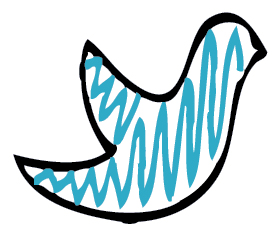
Twitter is no doubt a force to be reckoned with given its power to grab the world’s attention. It has been embraced globally as a channel for tweeting against injustice, especially by people in countries where freedom of speech would have previously been impossible. That’s why there was a global uproar when Twitter announced its plan to censor certain tweets in certain counties, those that contain content deemed to be illegal by their governments. The move immediately prompted an international outcry, along with calls for a boycott from some users.
“Thank you for the #censorship, #twitter, with love from the governments of #Syria, #Bahrain, #Iran, #Turkey, #China, #Saudi, and friends,” wrote Bjorn Nilsson, a Twitter user in Sweden.
Today, if someone posts a message that insults a country’s monarchy or government, which is punishable by a jail term, it is blocked and unavailable to Twitter users in that country, although still visible elsewhere. What’s more, Twitter users throughout the country in question are notified that something was removed: Where the tweet once would have been visible, it is now replaced with a gray box containing a clear note, as shown in Figure 9-1: “Tweet withheld. This tweet from @username has been withheld in: whatever country it is.”
Figure 9-1
Twitter users in censored countries are notified that their tweets have been withheld if they are deemed illegal.
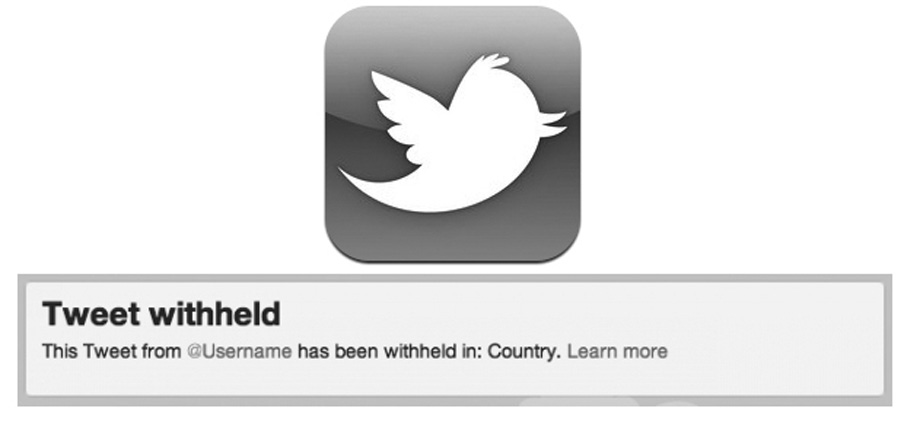
This is in stark contrast to the way Twitter was used during the Egyptian revolution of 2011. Twitter provided a platform for the frustrated civilians of Egypt to communicate and organize their revolt to overthrow the 29-year rule of President Muhammad Mubarak (see Figure 9-2). Mubarak’s administration was aware of the impact social media was having and took measures to have both Twitter and Facebook completely blocked by January 26, 2011.
By then, there was little the government could do to stop the events that were set in motion. It could not silence the voices of those who demanded change and who had embraced a new form of media to echo their cries.
Figure 9-2
Twitter provided a powerful global platform for the Egyptian revolution of 2011.
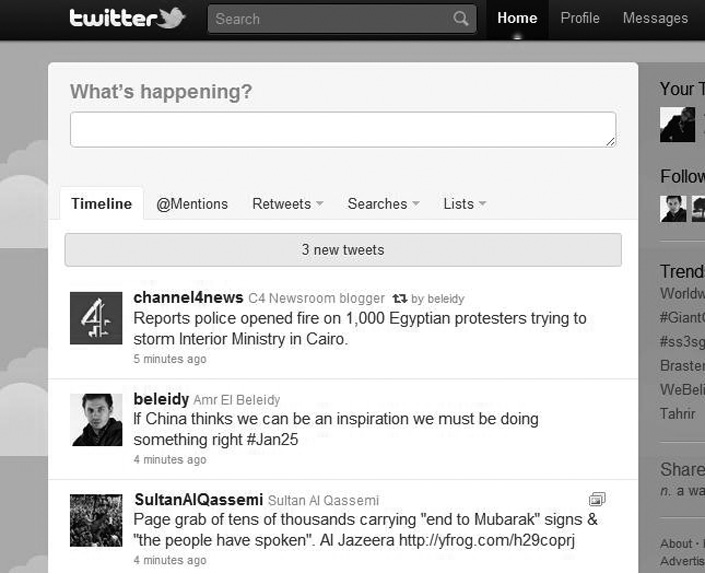
But the later announcement of geographical censorship by Twitter signaled the choice that it clearly had to make about its own existence: Should it be a tool for free speech that can be used in defiance of governments, as happened during the Arab Spring protests? Or are its intentions that of a commercial nature, a tool that must obey the laws of the lands where it seeks to attract customers and make money?
My belief is that Twitter wants to be all things to all people, a point driven home to me by the fact that the company identifies the locations of its users by looking at the Internet Protocol (IP) addresses of their computers or phones. However, it also lets users manually set their location to “worldwide,” which circumvents the blocking system entirely. For example, a user in Iran can simply change his or her location setting to “worldwide” and see everything tweeted.
Tweet Dreams Are Made in the USA
Despite the recent moves by Twitter to prevent rocking any political boats globally, the evidence increasingly shows that the worldwide adoption of the platform is slowly shrinking any geographical communication gaps. After all, the philosophies of the American dream, the land where Twitter and Facebook began — that of freedom of speech and all the things the Declaration of Independence stands for — have been woven into the social web and are seeping into the cultures that were previously denied their empowerment.
Social media has undoubtedly transformed the world into a multicultural global village; some would say one that has ironed out any cultural differences among us. Certainly on a conscious level we all seem to be tweeting from the same unified page, but there is another level that you need to understand to fully empower your personal brand with the knowledge needed to capture the widest global-audience possible.
Seeing the World through Culture-Colored Lenses
If you think about your Twitter followers in tribal terms, sectioning them into cultural groups, you may believe that the differences are slight. Our conscious behavior patterns support this, but culture isn’t a conscious element alone. Sure, people align themselves with others from the same geographical tribes, seeking out followers from towns and places they can relate to; on Twitter, like everywhere else, we like to find and connect with our birds of a feather.
But when factors like language barriers (which I explain later in this chapter) and class system are removed, are there really any boundaries stopping us from connecting with everyone, everywhere?
On a conscious level, perhaps no! But let’s shift our field of vision to consider the values, traditions, beliefs, and shared experiences that people carry with them unconsciously. By looking at social media behavior through these lenses, you’ll see profound cultural differences that influence both behavior and opinion.
East Meets West — Or Does It?
Factors such as cultural interdependency vary dramatically from culture to culture. For example, in many Eastern cultures, families play an important part in the day-to-day support structure of one another, sharing housing and intergenerational living. This is in stark contrast to Western society, where it is commonplace for families to scatter across cities, states, or even countries, and for different generations in a family to live independently of one another’s support.
This is not only a state of living, it is a state of mind. One that has been defined by Markus and Kitayama in their 1991 study on cultural variance, as “independent and interdependent self-construal.” In it, they conclude that the influence of nurtured culture dramatically affects behavior and communication patterns. So are we all unconsciously relating to our Twitter posts in a different way, depending on our internal cultural constructs?
A 2011 white paper, “Global Social Media Challenge,” by the research group Lewis Pulse suggests that cultural differences are still very much alive and kicking in social media and claims that “people from different nationalities react to social media in a way that has been predicted by social science.”
It found that countries such as the U.K, and the Netherlands, both Western cultures, showed a particular lack of willingness to accept authority. It also revealed that the Dutch in particular were extremely skeptical of corporate content and weren’t afraid to voice their opinions through their social networks. In complete contrast, the study found that those from Eastern cultures were generally more restrained overall in voicing any opinions that might rock the political or corporate boat.
To a psychologist, this is all fascinating, but how can these findings be used to empower your personal brand on a global scale?
Taking Your Brand Global
Despite any unconscious cultural biases, there has undoubtedly been a coming together of the independent and interdependent self-construals through the Twittersphere. Building emotional links to our fellow tweeters cross-culturally is like finding the ying to our yang in terms of depth of follower diversity and, ultimately, depth of engagement.
You probably wouldn’t be on Twitter if local community connections were all that interested you. You’re reading this book because you know that today, successful brands (of all sizes) need to spread their message through word of mouse as well as word of mouth. So here are some exercises you can do to help get you started building a global presence for brand “you.”
1. Observe and report
Social media has been around only a few years, but it continues to evolve. I’ve observed how Twitter in particular has grown in different countries at different rates. I’ve noticed the different directions users take on certain social media platforms, and I carefully follow the issues where cultural differences inevitably clash.
Monitoring how businesses and brands in other countries use social media can be an enlightening process, one that can inspire you to try out new ideas to spread your personal brand message. Monitoring also lets you spot new trends in other areas of the world, which might in time affect your own industry.
Be creative in how you source this information and be prepared to dedicate time for research. There are a variety of tools you can use, including Twitter’s search tools, websites, blogs, forums, videos, and podcasts.
Look for differences in web maturity, local infrastructure, and online habits, as these affect how users from other countries interact with social media on a daily basis and provide a useful indicator of what content they are looking for.
2. Don’t assume anything
We make assumptions based on our own personal reality, which is perfectly understandable. The trouble is that everyone has a different window on his or her view of reality, and what may seem perfectly natural to one person may seem completely alien to another.
A brand can’t survive in international business if it doesn’t embrace diversity. Cultural differences will continue to arise that provide challenges to our brand messages. The way to move forward is by not letting these cultural differences create barriers. You can thrive in an international environment only when you accept and embrace other people’s differences.
Embracing cultural awareness means accepting that you don’t know everything. It means acknowledging that you may have already acquired some false assumptions about other cultures as a result of naïveté or propaganda that have no basis in fact. Prejudice and prejudgments, whether conscious or unconscious, are a huge barrier to getting to know and understand different cultures, so embark upon your research with an open mind.
3. Give yourself a brand checkup
Without a doubt, the most successful international professionals I know are the ones with the clearest understanding of their own values, cultural baggage, and general self-awareness. In fact, throughout my years in international marketing, I was always aware that my strong sense of self-knowledge and belief in my own brand was a key factor in my brand-building success stories for others.
You see, when you know exactly where your personal limits are, the personal boundaries you have, and the value you put on your personal baggage, it is very easy to communicate strategically with others. Your self-knowledge has removed any psychological barriers that could get in the way of you achieving your goals.
So give yourself a reality check from time to time and make sure that you’re as resolute about your personal brand message today as you were on Day One. Regularly revisit it and revise it if necessary to incorporate any new values or considerations you may have picked up on your global journey of discovery. Think of it as your regular brand checkup.
A Question of Language
When looking at the aspect of language, the first question you need to ask yourself is whether your personal brand needs translation.
With English being the dominant language in the social sphere, it’s actually quite easy to overlook the language aspect of your brand-messaging strategy. Having said that, your Twitter followers may not always tweet in English. In fact, you might want to follow non-English-speaking tweeters if they’re connected to or influential in your field in some way that makes them valuable to your personal brand.
There are interesting aspects to language use in social media that are worth paying attention to when engaging with a global audience. One of these is the concept of the borderless social web, where followers can converse freely with others in their native tongues, regardless of whether it is English, French, or Chinese, thereby removing any language borders, as the term “borderless” suggests.
The Twitter Translation Center
Twitter has recognized and embraced this need and has developed the Twitter Translation Center to make borderless engagement a reality. It is continually calling on volunteer translators to take those tweets and links on Twitter that interest them and translate them for speakers of their native languages to enjoy across the globe (see Figure 9-3).
Once volunteers sign in to the Twitter Translation Center, they can start contributing to projects, including Twitter.com, Twitter’s mobile apps, Twitter Help, and Twitter for Business. The center also includes a leader board of top translators, along with a level system to encourage both community and competition between translators.
Figure 9-3
The Twitter Translation Center promotes borderless engagement through conversation among global Twitter users in their native languages.
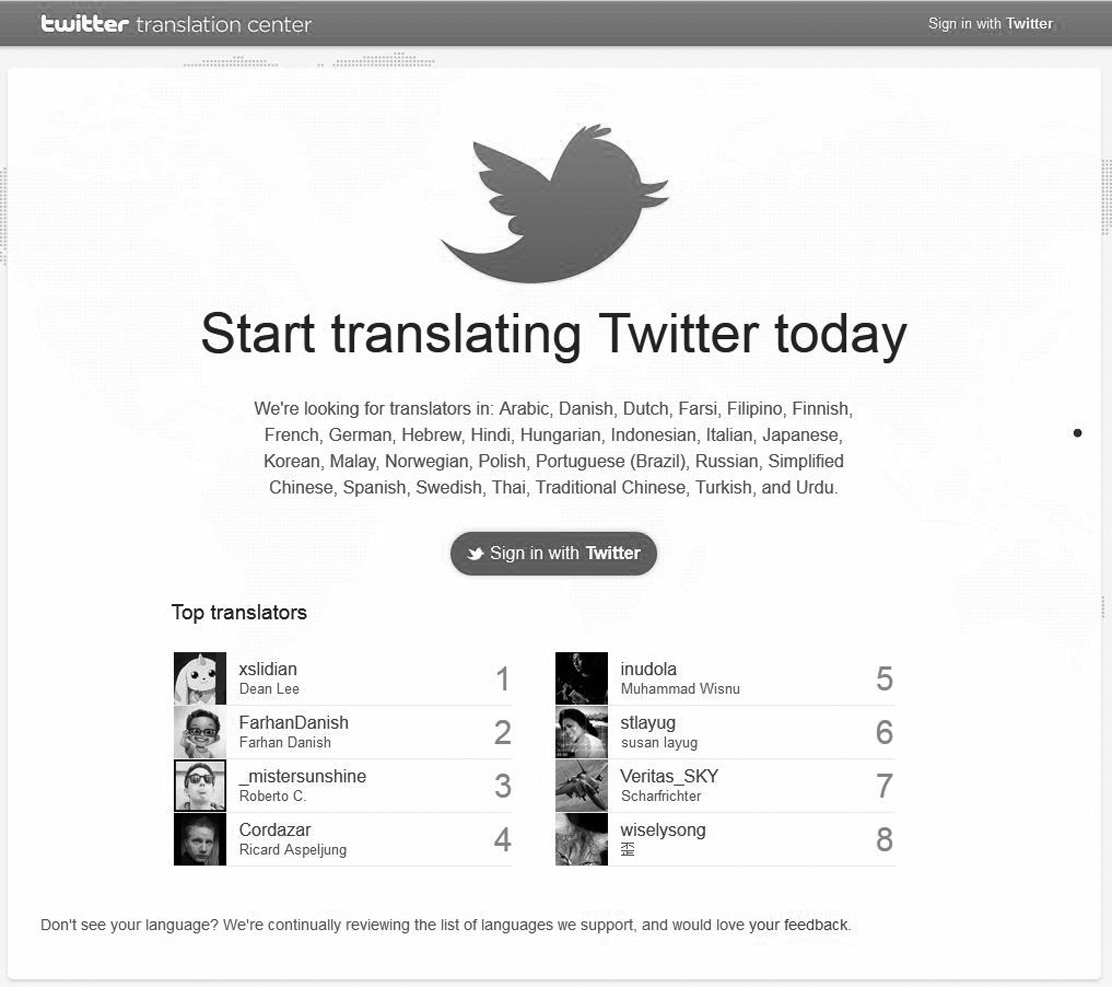
Google Translate
Although not linked to Twitter, Google Translate (see Figure 9-4) is an amazing tool that uses advanced translation technology. By looking for patterns in documents that have already been translated by human translators, Google Translate makes intelligent guesses for approximate translations.
Although not all translations are perfect, this tool is constantly evolving and growing as it learns more from human-translated documents. To use it, simply copy and paste your tweet into Google Translate at translate.google.com, define your required languages, and voilà!
You can then translate your reply or comment and copy and paste it back into Twitter to continue the conversation in that language.
Figure 9-4
Google Translate is a quick, easy, and sufficiently accurate translation tool.

Twinslator
Twinslator (see Figure 9-5) is a free Twitter app that twins your tweet from your original language to your desired language and then gives you the option to tweet them both simultaneously.
From its minimalistic home page (www.twinslator.com), you simply type in your tweet and then select one of 42 languages from the pop-up menu before clicking the Translate button. You can opt to send only the translated tweet or both the original and the translated tweets.
Figure 9-5
Twinslator provides a clutter-free direct-to-Twitter translation experience.

Twanslate
Twanslate is an experimental add-on for the Mozilla Firefox browser that translates an incoming tweet from a variety of different languages into English. Using Google’s Translate service, the Firefox add-on functions as a simple icon button (a little globe icon) below any tweet in another language. You simply click on the icon button to translate that particular tweet into English, as shown in Figure 9-6.
Figure 9-6
Twanslate is a Firefox add-on that translates your tweets using Google Translate directly in Twitter.
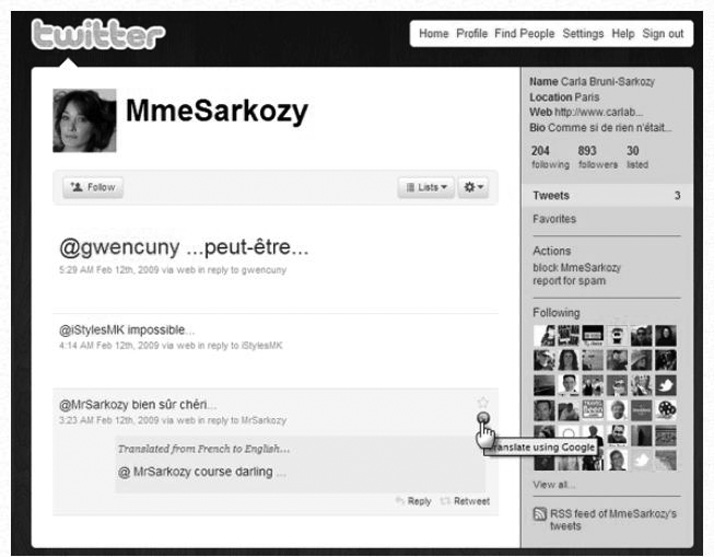
Twitter Auto-Translate
Twitter is beta-testing an auto-translation tool based on Microsoft’s Bing Translator, which supports 38 languages. With the translator, you can click on a non-English tweet and view the translated version immediately below it.
Twitter began rolling out this feature to a small percentage of accounts in February 2012; broad availability is expected by 2013.
Tweeting for Time Zones
I explain the benefits of repeat tweets in Chapter 8 as part of your personal brand show on Twitter, and there’s no better rationale for this than the time zone differences you need to consider when planning a cross-cultural strategy.
Get to understand your most active global communities by breaking them down into clearly defined sections, country by country. Then map them visually, using tools such as TweepsMap (see Figure 9-7) or Map My Followers, both free follower-mapping apps. (Note that Map My Followers works only for Twitter accounts with fewer than 50,000 followers.)
Figure 9-7
TweetsMap lets you see your followers from a geographical perspective.
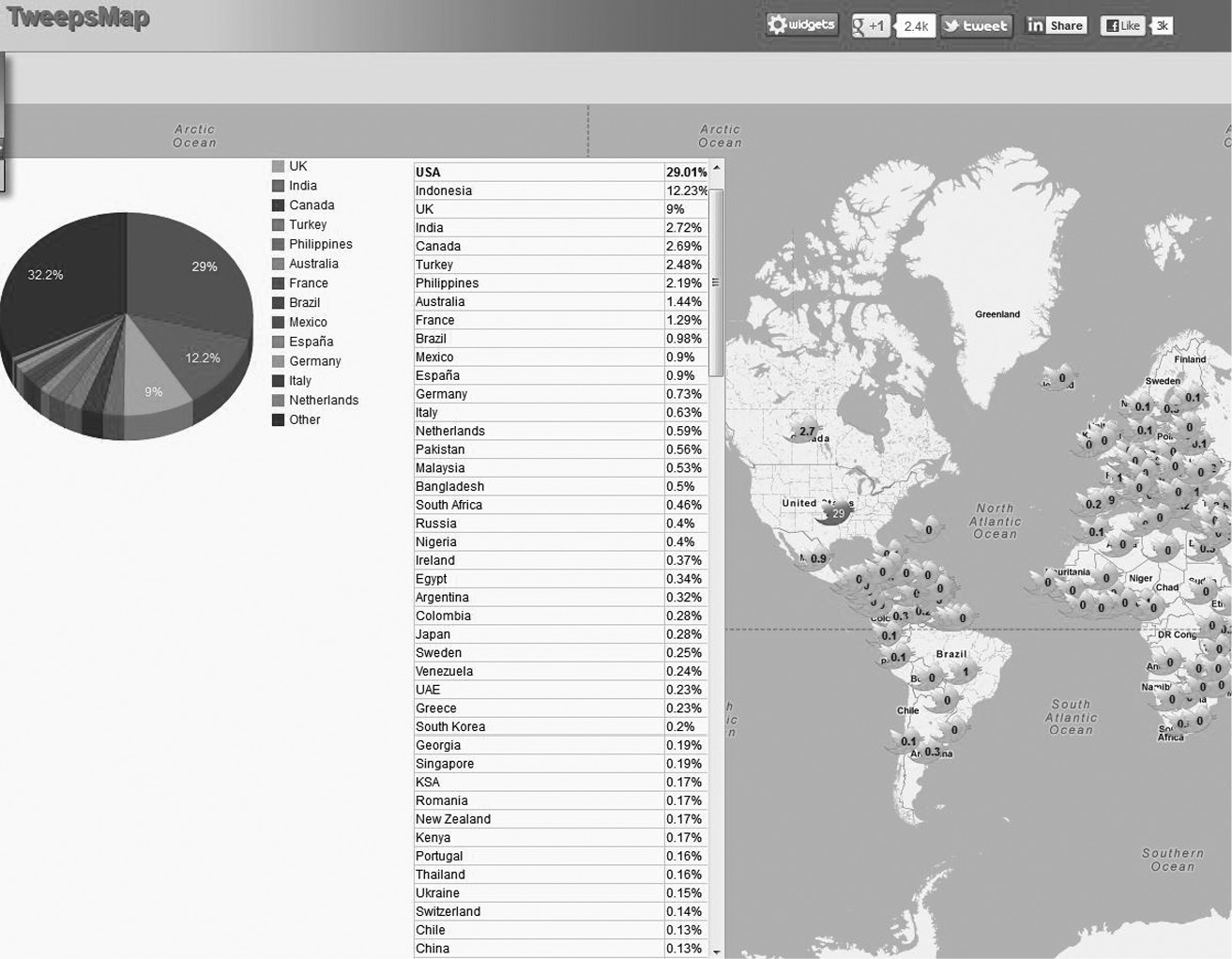
You can then use tools such as Buffer, which I cover in Chapter 8, to find the best possible times to schedule your tweets for each group, based on location.

